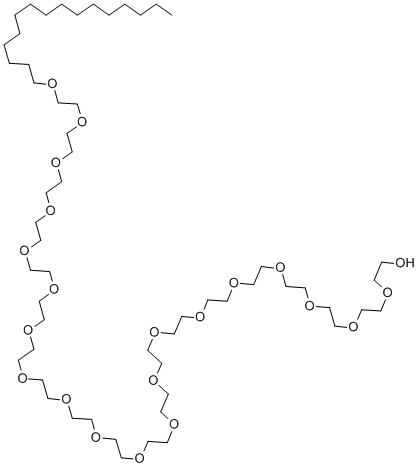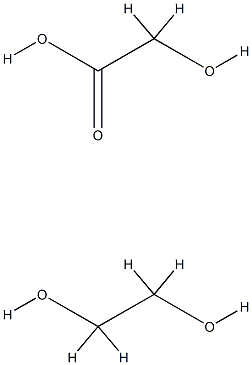Polyethylene Glycol Monocetyl Ether
Synonym(s):Brij 58;Brij C10;Brij 52;Polyoxyethylene (10) cetyl ether;Polyoxyethylene (2) cetyl ether
- CAS NO.:9004-95-9
- Empirical Formula: C56H114O21
- Molecular Weight: 1123.5
- MDL number: MFCD00080892
- EINECS: 500-014-1
- SAFETY DATA SHEET (SDS)
- Update Date: 2025-12-17 09:49:15

What is Polyethylene Glycol Monocetyl Ether?
Chemical properties
off-white waxy solid
The Uses of Polyethylene Glycol Monocetyl Ether
Polyethylene glycol hexadecyl ether, or Brij 58, has been used in a study to assess properties of gemini-conventional surfactant mixtures and their effects on solubilization of polycyclic aromatic hydrocarbons. It has also been used in a study to investigate RNase-sensitive constraint of bacterial nucleoid structure.
The Uses of Polyethylene Glycol Monocetyl Ether
ceteth is used as a surface active agent in cosmetics. It is a compound of derivatives of cetyl, lauryl, stearyl, and oleyl alcohols mixed with ethylene oxide.
The Uses of Polyethylene Glycol Monocetyl Ether
Brij? C10 is a surfactant that can be used for applications such as: improving the wetting of PEDOT:PSS which can further be used in the fabrication of thin film transistors, formation of reverse micelles for the synthesis of high yielding nanostructures, in the preparation of platinum electrode for fuel cell applications
General Description
Brij 58 is a nonionic surfactant or detergent for protein extraction and permeabilization of cells. It may be used in the preparation of yeast spheroplasts.
Flammability and Explosibility
Non flammable
Properties of Polyethylene Glycol Monocetyl Ether
| Melting point: | 41-49 °C |
| Boiling point: | 35.4-39.6 °C |
| Density | 0.978 g/mL at 25 °C(lit.) |
| vapor pressure | 0.26 psi ( 20 °C) |
| refractive index | n |
| Flash point: | >230 °F |
| storage temp. | Store below +30°C. |
| solubility | 2300g/L in organic solvents at 20 ℃ |
| form | Pellets |
| color | White |
| Specific Gravity | 0.978 |
| Odor | at 100.00?%. mild alcohol waxy fresh |
| BRN | 6450627 |
| Hydrophilic-Lipophilic Balance (HLB) | 15.7 |
| Stability: | Stable. Combustible. Incompatible with strong oxidizing agents. |
| CAS DataBase Reference | 9004-95-9 |
| EPA Substance Registry System | Polyethylene glycol monocetyl ether (9004-95-9) |
Safety information for Polyethylene Glycol Monocetyl Ether
| GHS Hazard Statements |
H412:Hazardous to the aquatic environment, long-term hazard |
| Precautionary Statement Codes |
P273:Avoid release to the environment. P501:Dispose of contents/container to..… |
Computed Descriptors for Polyethylene Glycol Monocetyl Ether
Polyethylene Glycol Monocetyl Ether manufacturer
New Products
Sodium glycochenodeoxycholate, >98% Indole Methyl Resin tert-butyl 9-methoxy-3-azaspiro[5.5]undecane-3-carboxylate Gabapentin EP Impurity A 2,5-dichloro-N-hydroxy-4,6-dimethylpyridine-3-carboximidamide 4-Chloro-7-tosy1-7Hpyrrolo[2,3-d]pyrimidine 1,3-Diphenylurea 1,1’-CARBONYLDIIMIDAZOLE R-2-BENZYLOXY PROPIONIC ACID N-METHYL INDAZOLE-3-CARBOXYLIC ACID Zinc Bis-glycinate 2-Hydroxy-5-nitroacetophenone 2,4-dihydroxybenzaldehyde 3-(4-morpholinophenylamino)-5-amino-1H-pyrazole-4-carbonitrile 1,3-Diethyl-1,3-Diphenylurea Methyl 2-methylquinoline-6-carboxylate 2-((4-morpholinophenylamino) (methylthio) methylene) malononitrile 2-HYDROXY BENZYL CYANIDE DIETHYL AMINOMALONATE HYDROCHLORIDE 5-BROMO-2CYANO PYRIDINE Boldenone Clarithromycin Ethinyl Estradiol StanozololRelated products of tetrahydrofuran







![Glycols, polyethylene, methyl 3-[1,3,3,3-tetramethyl-1-(trimethylsiloxy)disiloxanyl]propyl ether](https://img.chemicalbook.in/)
You may like
-
![Polyethylene Glycol Monocetyl Ether (n=approx. 23) [for Biochemical Research] CAS 9004-95-9](https://img.chemicalbook.in//Content/image/CP5.jpg) Polyethylene Glycol Monocetyl Ether (n=approx. 23) [for Biochemical Research] CAS 9004-95-9View Details
Polyethylene Glycol Monocetyl Ether (n=approx. 23) [for Biochemical Research] CAS 9004-95-9View Details
9004-95-9 -
 Brij-58® (Polyethylene Glycol Cetyl Ether CAS 9004-95-9View Details
Brij-58® (Polyethylene Glycol Cetyl Ether CAS 9004-95-9View Details
9004-95-9 -
 Polyethylene Glycol Monocetyl Ether (n=approx. 23) CAS 9004-95-9View Details
Polyethylene Glycol Monocetyl Ether (n=approx. 23) CAS 9004-95-9View Details
9004-95-9 -
 Brij-58 (Polyethylene Glycol Cetyl Ether CAS 9004-95-9View Details
Brij-58 (Polyethylene Glycol Cetyl Ether CAS 9004-95-9View Details
9004-95-9 -
 Polyoxyl 20 cetostearyl ether CAS 9004-95-9View Details
Polyoxyl 20 cetostearyl ether CAS 9004-95-9View Details
9004-95-9 -
 Anti-BLCAP antibody produced in rabbit CASView Details
Anti-BLCAP antibody produced in rabbit CASView Details -
 Brij® 58 CAS 9004-95-9View Details
Brij® 58 CAS 9004-95-9View Details
9004-95-9 -
 58View Details
58View Details
9004-95-9
